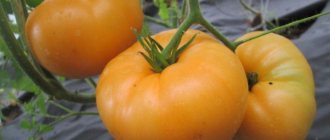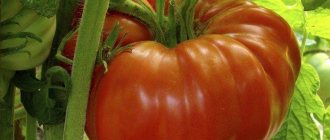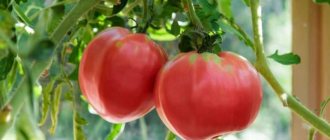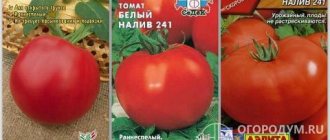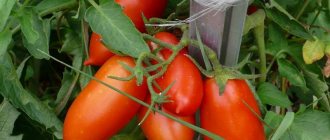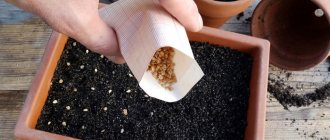Characteristics of the variety
In addition to the original color, the variety also distinguishes itself from other varieties of tomatoes with its rich, bright taste. It is sweet and with only a minimal, barely noticeable sourness.
Today it is not known exactly which of the breeders brought out the unusual new product. But it quickly began to spread in different regions of Russia. Today, the Azure giant is often grown by experienced gardeners on their plots. Its shade is also called black-violet, with a distinct chocolate tint.
It is known that the variety was originally bred specifically for greenhouse conditions. But gradually gardeners came to the conclusion that even in open beds the crop grows well under suitable weather conditions. But this only applies to southern regions with warm, humid summers.
Despite the name, the plant does not grow gigantic at all. The height of the bushes under any conditions is rarely higher than 90-100 cm. The crop has a fairly strong trunk and branches. They have a light green tint and are overgrown with thick, beautiful, medium-sized leaves.
Clusters usually form on the lower branches. They are also present in the upper part of the bush, but there they become much smaller. This also applies to the vegetables themselves. The lower, the larger the fruit. Small tomatoes ripen in the upper part of the bush. At the same time, both the stem and branches of the plant need proper garter so that they do not break or fall to the ground under the weight of the harvest.
Vegetables have thick and strong skin. It allows the crop to be stored well and not crack. You can transport tomatoes over long distances if you place them in boxes correctly and carefully.
Separately, it is worth noting the huge weight of vegetables. The weight of individual fruits on the bushes can reach 750-800 g. As a result, one tomato is sometimes enough to prepare a full meal. Small variety tomatoes weigh about 200-250 g.
Gardeners who have already tried to grow the Azure Giant variety on their plots agree that this is a very tasty variety of tomatoes. They have an unusually bright, rich and pleasant taste and aroma. The purpose of vegetables is universal. They can be eaten raw, sliced, added to salads, gravies, and various oven-baked treats. Thick soups are cooked on the basis of the tomatoes under discussion, juices, ketchups, pastes, and sauces are prepared.
It is allowed to roll the fruits into jars for the winter or freeze them for storage. But for such purposes you will need to choose the smallest vegetables from the entire harvest. Tomatoes retain their shape perfectly even after boiling or thawing.
Among all the modern varieties bred by breeders, the Azure Giant is one of the most productive. From just 1 bush, with proper care, you can harvest up to 9-10 kg of ripe vegetables. They will all be tasty, juicy – round and slightly flattened.
The fruits ripen quite quickly. This process usually takes 102-115 days. By the first frost, the entire harvest can be fully harvested and the greenhouses prepared for next year. This is true even for the middle zone.
smart
The unusual hybrid has strong immunity. It is quite resistant to the most common diseases of all nightshades. Proper prevention helps to further increase this indicator. For example, if a gardener knows that certain pests live on his site, fresh plantings of tomatoes can be immediately treated with store-bought products to prevent their proliferation on the bushes.
The variety does not tolerate low temperatures well. The culture feels best in warm regions. Even heat is more comfortable for the Azure Giant than cold. Usually the plant does not encounter frosts, since both the harvest and crop residues in the beds are harvested in late summer and early autumn.
Tomato “Azure Giant F1”: variety description
| Variety name | Azure Giant F1 |
| general description | Mid-season determinate hybrid |
| Originator | The issue is controversial |
| Ripening period | 105-115 days |
| Form | Flat-round with pronounced ribbing at the stalk |
| Color | Black-violet with chocolate shimmer |
| Average weight of tomatoes | 200-700 grams |
| Application | Universal |
| Productivity of the variety | about 10 kg per bush |
| Features of cultivation | Productivity is highly dependent on growing conditions |
| Disease resistance | Quite resistant to major nightshade diseases |
“Azure Giant F1” is a mid-season hybrid.
The bush is determinate, up to 1 m high. The first clusters bear 4-6 fruits, subsequent clusters are smaller. The bush requires the formation and obligatory tying of heavy branches. Productivity is average, highly dependent on maintenance conditions. From one bush you can get about 20 tomatoes per season. The fruits are large, weighing up to 700 g . On the upper clusters, the tomatoes turn out to be smaller, about 200 g. The shape is flat-round, with pronounced ribbing at the stalk. The peculiarity of the hybrid is the original color of the tomatoes, black and purple with a chocolate tint. The pulp is dark red, dense, juicy, with a pleasant sweet taste. The number of seed chambers is average, the skin is dense, but not hard.
You can compare the weight of the fruits of this variety with other varieties in the table below:
| Variety name | Fruit weight |
| Azure Giant | 200-700 grams |
| Evpator | 130-170 grams |
| Gypsy | 100-180 grams |
| Japanese truffle | 100-200 grams |
| Nobleman | 300-400 grams |
| Cosmonaut Volkov | 550-800 grams |
| Chocolate | 200-400 grams |
| Spasskaya Tower | 200-500 grams |
| Newbie pink | 120-200 grams |
| Palenque | 110-135 grams |
| Pink icicle | 80-110 grams |
Advantages and disadvantages
The Azure Giant tomato, the description of the variety and photo of which can be studied above in the article, has a whole list of pros and cons. The latter are much smaller. Both lists are useful and even necessary for every gardener to study. Based on them, it will be easier to make the right conclusion whether it is worth planting a crop on your summer cottage.
Among the advantages of the variety are:
- unusual rare and appetizing appearance;
- bright pleasant taste, aroma and versatility of using vegetables;
- long-term storage of fruits and the possibility of transporting them over long distances;
- strong immunity (the crop is not susceptible to spotting, mosaics and other diseases common among tomatoes);
- high yield with proper care and comfortable conditions.
Tomato Azure giant.
Among the disadvantages, experienced gardeners primarily note the dependence of the number of fruits ripened during the season on growing conditions. If the plant feels uncomfortable in any way, its yield may be significantly reduced.
Another disadvantage is the need to tie up the bushes and form them properly regularly. The absence of such procedures can also negatively affect the yield of the variety. Untied bushes often break off under the weight of vegetables or fall down, and the fruits end up lying on the ground. In this form, tomatoes spoil faster.
Characteristics
"Azure Giant F1" was bred by Russian breeders. Suitable for growing in greenhouses, greenhouses or open ground. In shelters, the yield is higher, the collected fruits are well stored, and transportation is possible.
The fruit is used for salad purposes; it is tasty fresh and suitable for preparing various dishes: appetizers, soups, side dishes, pastes and purees. Ripe tomatoes produce delicious thick juice. The fruits can be used for canning.
Among the main advantages:
- high taste qualities of fruits;
- harvested tomatoes are stored well;
- resistance to diseases.
Among the disadvantages, some gardeners note unstable yields, which greatly depend on growing conditions. The bushes require shaping and moderate pinching.
You can compare the yield of this variety with other varieties in the table below:
| Variety name | Productivity |
| Azure Giant | 10 kg per sq.m. |
| Pink heart | 9 kg per sq.m |
| Crimson Sunset | 14-18 kg per sq.m. |
| Inseparable hearts | 14-16 kg per square meter |
| Watermelon | 4.6-8 kg per sq.m |
| Giant Raspberry | 10 kg per bush |
| Black Heart of Brad | 5-20 kg per bush |
| Crimson Sunset | 14-18 kg per square meter |
| Cosmonaut Volkov | 15-18 kg per sq.m |
| Evpator | up to 40 kg per sq.m |
| Garlic | 7-8 kg per bush |
| Golden domes | 10-13 kg per sq.m |
Sowing seeds
The Azure Giant tomato, a description of the variety and photo of which can be found above in the article, requires special attention from the gardener to planting seeds and growing seedlings. It is important to strictly follow all the main stages and provide the seedlings with maximum comfort before planting in a permanent place.
It is necessary to start working with seed material in March - before the middle of the month. The easiest way is to buy seeds, packaged in portioned bags, in a specialized store. Typically, such seed is already properly prepared by the manufacturer. Therefore, there is no need to further disinfect it or try to find empty grains.
It is enough just to treat the seeds with a growth stimulator and dry them. Afterwards you can also harden them for several days. To do this, the grains are scattered on paper or cloth and in this form are either put into the refrigerator, then removed and left on the table at room temperature. The procedure is repeated several times.
Before planting the seeds, you need to prepare the ground for them. You can buy a ready-made mixture at a gardening store. Typically, such soil is marked: “for tomatoes” or “for seedlings.” But it is also possible to independently prepare the soil for future seedlings. It is best to make a mixture of humus, black soil, wood ash and sand (coarse).
The nutritional mass is sent to spacious, wide boxes. They can be low - 10-15 cm in height. Containers must have holes at the bottom so that excess liquid accumulated after watering flows out.
Small grooves are made in the soil into which the seeds are planted. It is enough to deepen them 0.5-1 cm. The top of the plantings is lightly sprinkled with soil.
Growing seedlings
After planting, containers with future seedlings are removed to a warm place. The temperature in it should be at least 25 degrees. If such natural conditions cannot be created, you can cover the structure with cling film.
High-quality lighting is important for seedlings. If necessary, LED lamps can be used.
Seedlings should be regularly watered at the root to prevent moisture from getting on the leaves.
For “hygienic procedures”, warm water is used, standing for at least 25 hours. It is convenient to pour it with a spoon or syringe. It is advisable to additionally and regularly feed the plantings with fertilizers suitable for seedlings. When the first shoots appear, the room temperature should be reduced. If the seedlings grow with the film, the covering is removed. At this stage, the most comfortable temperature for them will be 15-16 degrees Celsius. Under such conditions, the seedlings are left for 6-8 days. This is necessary so that the root system develops better and becomes stronger. Afterwards, the room temperature can again be raised to 21-23 degrees Celsius.
All this time, regular watering of the plantings with warm water continues. Hygiene procedures are repeated approximately once every 10 days. The water must be settled.
Picking
When the first true leaves have already unfolded, you will need to pick the seedlings. To do this, they are carefully distributed into separate small glasses. It is especially convenient to use peat portion containers rather than plastic ones. In the future, you won’t have to remove seedlings from them and spoil their root system. It will be possible to transplant young sprouts directly into the ground with pots. Peat quickly dissolves in the soil, providing plantings with additional nutrients.
When the seedlings are already tall and strong enough, it is worth starting to harden them. To do this, individual small sprouts in containers are taken outside. First for 5-7 minutes, then for half an hour. Every day you can add about 30 minutes so that the seedlings end up standing outside until the evening.
It must be remembered that in small cups the soil dries out very quickly. Therefore, plantings may require watering more often. Sometimes - daily. Their optimal frequency can be determined by the state of the earthen coma. You can pinch off small pieces of soil and try to rub them in your fingers.
Landing in the ground
The Azure Giant tomato can be transplanted to a permanent location around May (by the end of the month). If the seedlings are moved directly to the greenhouse, then this can be done earlier. This is confirmed by the description of the variety with the photo.
In the process it is necessary:
- Thoroughly loosen and water the prepared beds with warm water. They are weeded in advance so that no remains of last year’s plants remain in the ground. The latter can serve as sources of various infections.
- Make neat holes in the beds. Immediately put a small handful of wood ash into each. You can also take store-bought complex fertilizer mixtures.
- Lower the seedlings into the holes, being especially careful when handling their roots. Sprinkle the plantings with soil on top.
- Water the bushes.
No more than 3 seedlings should be placed on each square plot. If the planting is too dense, it may interfere with the plants’ development and negatively affect the harvest. The bushes grow quite spreading, so they need space.
It is optimal to leave 45-55 cm between the holes. And between the rows - 65-75 cm.
If it is difficult to decide on your own the required amount of fertilizer for each hole when planting, then you can rely on the following scheme: 1 tsp. superphosphate + 1-1.5 tbsp. l. mixtures of ash and eggshells. This portion is calculated for one hole before placing the bush in it.
Also, each hole requires a lot of water when planting. Approximately 1-1.5 liters of liquid is poured into one recess.
After planting the seedlings, it is advisable to hill the beds. If desired, you can mulch them. For example, hay. This trick allows you to maintain the optimal level of soil moisture for longer and significantly reduce the amount of weeding - weeds in the beds will grow more slowly.
Features of agricultural technology of an extraordinary hybrid, reviews from gardeners
Tomato seedlings are planted in the ground. Sowing is carried out throughout March. By the beginning of May, young greenery will be ready to be transplanted into a greenhouse or hotbed, and at the beginning of June - into the garden. The plant bears fruit for about 2 months, starting in mid-July. Planting pattern on the site: 50×70 cm. Per 1 sq. m place 3 bushes.
Expert advice:
- The best productivity of a tomato is achieved when formed into 1-2 stems;
- Start pinching the plant after tying 3-4 tassels;
- Place a support on the bed, start gartering from the 2nd week of life.
Not all gardeners are satisfied with growing this hybrid. People have trouble getting pure purple tomato skin. Natalya from Ulyanovsk region. showed a photo of her ripe harvest. There is blueness on it only at the stalk. She also did not like the mediocre yield of the crop - 4 tomatoes per bush. Galina (Vologda region) in her review confirmed the description of the tomatoes not matching in color. But her harvest was decent. Otherwise, the variety confirmed its qualities, which is why the summer resident liked it.
Azure giant F1 is a tomato with tempting properties and extraordinary color. But gardeners do not confirm some of the advantages declared by breeders.
Watering, fertilizing
The Azure Giant tomato, a description of the variety and photo of which would be useful for every gardener to study, requires comprehensive, high-quality and regular care. One of the main procedures in the process is watering the bushes. There is no single figure that suggests the optimal frequency of treatments for a variety. Each vegetable grower will have to determine it independently. To do this, the condition of the soil and weather conditions are assessed.
It is very important to water the crop exclusively with warm, settled water. If you use cold liquid, it can not only slow down the growth of bushes, but also negatively affect the ripening of fruits. Often, watering the bushes once every 8-10 days is sufficient. This is true for regions where there is no extreme heat. In very warm and non-rainy areas, the number of treatments usually needs to be increased.
During the irrigation process, water is sent exclusively to the root of the plant. You cannot pour it on the leaves and stem of the crop. It is best to organize watering in the evening. Cloudy days are also suitable.
In order for the plant to grow well, and its fruits to ripen in a timely manner, to be sweet and tasty, it is necessary to regularly add fertilizer to the soil. In total there should be at least 4 feedings per season. You can use both organic and mineral fertilizers. For example, alternate them. Organic fertilizers include mullein, herbal infusions or bird droppings. The easiest way to use mineral ones is to use store-bought ready-made water-soluble complexes.
The table will help you deal with fertilizing:
| Feeding | Peculiarities |
| 1 – after planting and before flowering | You can use a growth stimulator and Kornevin. It is important not to overdo it with organic matter at this stage, so that a very large bush does not develop, which will not have the strength to form large fruits. Nitrogen fertilizers can delay flowering or even cause small vegetables. |
| 2 – during the flowering period | At this stage, the plant needs potassium. But this substance is capable of taking other microelements from the bushes. Therefore, the fertilizer must contain nitrogen, phosphorus and potassium at once, but most of the latter. You can also use droppings and nettle infusion. |
| 3 – after the appearance of the ovaries | The previous root feeding is repeated with a predominance of potassium in the composition. |
| 4 – during ripening | Fertilizers are selected depending on the condition of the bush. If its lower leaves turn yellow, a urea solution is used. If a yellow edge appears on the leaves - potassium sulfate. If the foliage turns purple on the reverse side - superphosphates. |
Planting and care
We recommend sowing the seeds of this tomato variety for seedlings 60-65 days before the intended planting in the ground. Seedlings dive at the stage of two true leaves. When planting seedlings in a permanent place per 1 sq. It is recommended to place up to 3 plants per meter of land; when forming into 1 stem - up to 4.
Further care for tomatoes consists of timely watering, removal of weeds, fertilizing with complex mineral fertilizer, pinching and preventive measures to protect the crop from diseases and pests.
Proper planting and proper care ensure a good harvest of the “Red Giant”.
When preparing the soil for seedlings, pay special attention to disinfection: soak the seeds in a solution of potassium permanganate, and then rinse in running water. For the same purposes, it is recommended to scald the soil with boiling water. It needs to be moistened before sowing.
Then depressions up to 2 cm are made, seeds are planted in them and sprinkled with earth. Watering is done once every 3 days. Seedlings should be kept in a room with a temperature of 23-25 degrees. After the sprouts appear, the seedlings are transferred to the ground
Before sowing, it needs to be moistened. Then depressions up to 2 cm are made, seeds are planted in them and sprinkled with earth. Watering is done once every 3 days. Seedlings should be kept in a room with a temperature of 23-25 degrees. After the sprouts appear, the seedlings are transferred to the ground.
2-3 plant bushes are planted per 1 square meter of soil. The soil can be covered with mulch (chopped grass and plants). Water the tomatoes with settled water. The greenhouse must be systematically ventilated to prevent fungal diseases.
At the growth stage, complex feeding is needed: every 10 days it is recommended to alternate organic and mineral fertilizers (with phosphorus and potassium).
During the period of active growth, “Red Giant” is watered once a week, spending 20-30 liters of water per square meter. During the flowering period, water twice a week, one and a half to two liters per meter. The appearance of ovaries is accompanied by watering twice a week, 3-5 liters (if it is very hot, the volume is increased to 10 liters).
When the first fruits appear, it is worth watering only if the soil is very dry. The optimal time of day for watering is morning, since at this time of day the sun is not too aggressive and the soil has time to absorb all the moisture.
The large weight of this variety of tomatoes weighs down the stems, and if there are a lot of fruits, it may break.
The bushes are pruned once a week, leaving the shoot to form a stem. It is better to do this in the evening (when it is not hot).
3 bushes are placed per 1 m2. Planting pattern 50*60 cm.
For significant yields:
- bushes lead to 1-2 shoots;
- mulch with straw or hay in a 10 cm layer;
- apply fertilizers during flowering, setting, ripening;
- water 2 times a week, 6-7 liters per bush.
Mid-season / Tall
User rating: 4/5
Mid-season / Tall
User rating: 5/5
Mid-season / Tall
Stepsoning
One of the main characteristics of the variety is the branching of the bushes. Therefore, the culture requires regular stepsoning. This procedure provides better access to light. As a result, the ovaries on the bushes are perfectly formed and the fruits are formed in a timely manner. It is worth considering that the crop needs sunlight for 10-12 hours every day. This is true for the entire summer season.
It is best to start pinching 15-17 days after planting the crop in a permanent place. It is recommended to trim excess shoots early in the morning on a sunny day. This is necessary so that the wounds have time to dry before evening. It is very important to use the sharpest and cleanest possible tool. For example, a pruner. It is advisable to disinfect it regularly.
During the process, it is worth cutting off the stepsons not at the root, but leaving stumps 2-4 mm long. Otherwise, new side shoots may begin to grow from the same leaf, which will also have to be cut off in the future. It is important to immediately remove all parts of the plant separated by pruning shears from the beds. To make your task easier, you can lay a film on top of the ground before the procedure and cut stepsons on it.
Tying up
It is necessary to tie up the stems of the Azure Giant. Otherwise, they will break or bend to the ground. In a greenhouse, the easiest way to do this procedure is to use small, strong stakes and install them near each individual bush. The optimal distance is 10 cm.
Shoots and stems of bushes are attached to supports in several places. The staking material should be soft and not too thin so that it does not cut the plant. For example, it is convenient to take ribbons and cord. As the bush continues to grow, it will be necessary to evaluate its condition and continue tying it to the stakes.
Bush formation
The Azure Giant tomato, the description of the variety and photos of which are published in detail by experts today, requires the mandatory formation of a bush. It is best to grow it in 1-2 stems. In the process, all excess stepsons are removed - broken off or cut off. The foliage is also thinned out. Before removing branches, their condition is assessed. Without pity, those that definitely will not bear fruit are pruned.
It is considered optimal to leave 1-2 of the largest, strongest and most viable stems. The rest are cut off. This should be done with a knife or pruning shears, stepping back 2-2 cm from the main trunk. Pinching stepsons is allowed only after 4 fruit clusters have formed on each bush. Previously, this procedure could weaken the plant.
Pest and disease control
The culture has strong immunity, as noted above. Therefore, it is rarely harmed by diseases and parasites. If pests are found on the site, then you can take preventive measures. For example, long sticky tapes are hung throughout the entire space against whiteflies in greenhouses. Even options designed for flies are suitable. Also, glue traps (yellow) can be used in general to control the number of insects flying in greenhouses.
Slugs from bushes must be collected. It is convenient to do this with your hands wearing thin gloves. Slugs are collected in glass jars and destroyed away from tomato plantings.
The leaves of the plant should be inspected regularly. If signs of spider mites or aphids are noticed on them, it is better to immediately treat the plantings with a soap solution. The leaves are washed last on all sides. Peat or straw mulch and regular weeding also help fight pests.
To prevent the development of various serious diseases, the soil in which young tomato bushes are planted should be treated with a solution of copper sulfate or potassium permanganate. Afterwards, you can use antifungal non-toxic drugs. For example, Fitosporin is good.
Tomatoes do not do well in conditions of high humidity. This is especially true for a greenhouse. As a result, fungal diseases may begin to develop. Dark spots on the underside of the foliage will help you notice the problem. Such leaves must be removed immediately. If no measures are taken, the plant may die. Fungicides help fight fungal infections.
Advantages and disadvantages of a hybrid
Fruits are the key advantage of a hybrid tomato. The originator placed emphasis on the unusual color of the crop. The company's photo shows the tomatoes as dark purple. They grow in clusters of 4-6 pieces.
The flesh is red, fleshy and sugary. The tomatoes are delicious. The main purpose is fresh salads. But they are quite suitable for thick sauce or juice processing.
Attention! Not the largest specimens from the tomato harvest would be suitable for integral preservation. But they have a soft, fragile skin and are prone to bursting when exposed to boiling water.
Other advantages of the hybrid:
- Large fruit size. Individual tomato specimens can weigh more than 300 g.
- Increased productivity. Up to 20 tomatoes are harvested from one bush.
- Contains a high proportion of useful substances - anthocyanins.
- The presence of stable immunity to the list of major tomato diseases.
Disadvantages of hybrid tomato:
- does not have high shelf life and transportability;
- does not develop well without solar heat (in summer the garden bed needs at least 10 hours of such lighting);
- needs a garter;
- requires ordering the number of stems.
Tips and tricks for growing
The Azure Giant tomato variety is well suited for experimenting with yields. To increase it, you will need to regulate the temperature in the greenhouse, use complex fertilizers and maintain an optimal watering schedule.
To combat insects, you can add not only wood ash to the soil, but also red pepper. The procedure can be carried out even before planting the seedlings in the beds.
The Azure Giant tomato allows you to get a large harvest of tasty and beautiful vegetables on your plot - a purple-chocolate hue. The description of the variety with the photo suggests that it requires special regular care. For this reason, the crop may be too difficult for beginners to grow.
Features of cultivation
Tomatoes "Azure Giant F1" are propagated by seedlings. Seeds are sown in the first or second half of March. Before sowing, they can be soaked in a growth stimulator for 10-12 hours. For seedlings, you need light soil from a mixture of garden soil and humus. You can add washed river sand and wood ash to the substrate. The seeds are sown with a slight depth, sprinkled with a layer of peat and sprayed with warm water.
For successful germination, the room temperature should not fall below 25 degrees. The hatched sprouts are placed in bright light. A south-facing window sill is preferable; in cloudy weather, additional lighting with powerful fluorescent lamps is required. You need to water the seedlings carefully using a spray bottle or strainer. When the first true leaves unfold, the seedlings are planted in separate pots.
After this, the sprouts are fed with a complete complex fertilizer. Seedlings must be hardened by taking them out into fresh air every day. Transplantation into the ground begins towards the end of May. Seedlings can be moved to the greenhouse earlier. For 1 sq. m, 3 bushes are placed, a small portion of complex fertilizers or wood ash is placed in each hole.
Plants should be watered as the top layer of soil dries, using only warm water. The bushes are formed into 1 or 2 stems, pinching the stepsons after the formation of 3-4 fruit clusters. During the season, plants need to be fed at least 4 times, alternating mineral fertilizers with organic matter.
Read on our website: how to get a high yield of tomatoes in open ground? How to grow delicious tomatoes in a greenhouse in winter? What are the subtleties of agricultural technology for early varieties?
